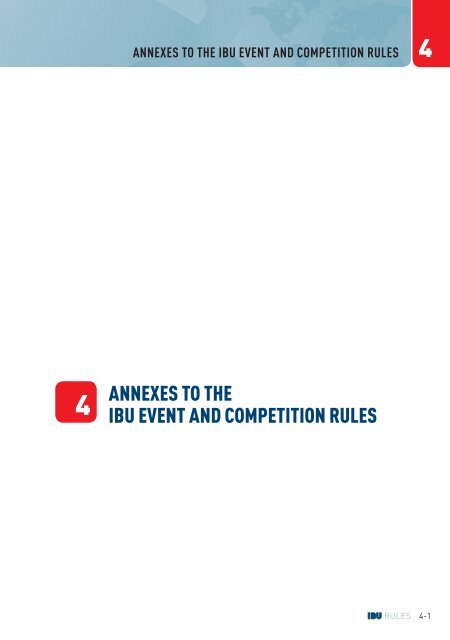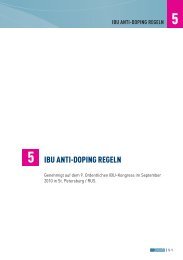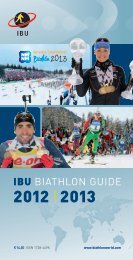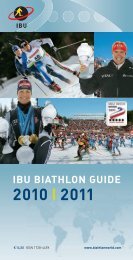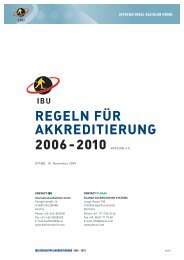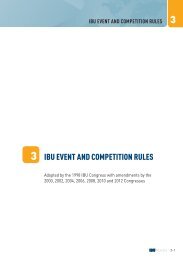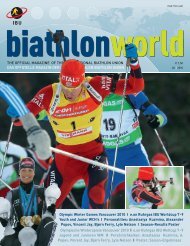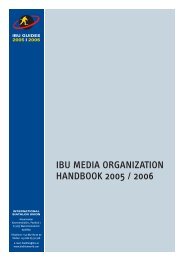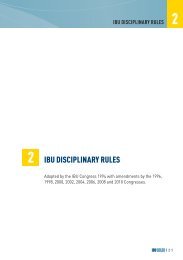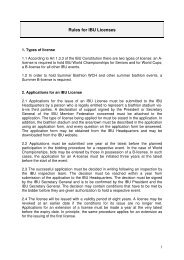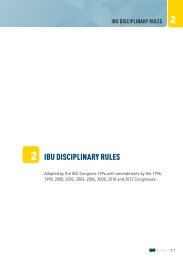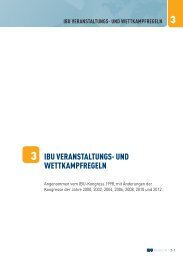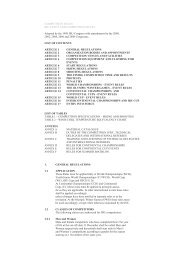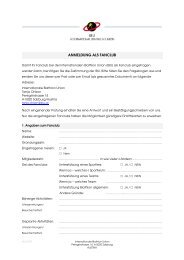annexes to the ibu event and competition rules - International ...
annexes to the ibu event and competition rules - International ...
annexes to the ibu event and competition rules - International ...
You also want an ePaper? Increase the reach of your titles
YUMPU automatically turns print PDFs into web optimized ePapers that Google loves.
ANNEXES TO THE IBU EVENT AND COMPETITION RULES44ANNEXES TO THEIBU EVENT AND COMPETITION RULESIBU RULES 4-1
ANNEX A 42. NEW MATERIALS2.1 DEFINITIONNew materials are defined as any <strong>competition</strong> equipment or organizationequipment that have not been approved or rejected by <strong>the</strong> IBU TC. Anynew materials must be submitted <strong>to</strong> <strong>the</strong> IBU TC for approval before <strong>the</strong>ycan be used in an IBU <strong>event</strong> or <strong>competition</strong>.2.2 APPROVAL PROCESS2.2.1 ProcedureAny new developments in materials produced by <strong>the</strong> industry or <strong>the</strong>NFs for <strong>the</strong> following season must be submitted <strong>to</strong> <strong>the</strong> IBU no later thanMay 1 of <strong>the</strong> year in which <strong>the</strong> season begins. The submission must beaccompanied by appropriate information material such as drawings,descriptions or test results. Pro<strong>to</strong>types may be submitted as well. Newdevelopments that are in compliance with <strong>the</strong> <strong>rules</strong> will be immediatelyapproved by <strong>the</strong> IBU TC.2.2.2 Provisional ApprovalIn rare cases provisional approval may be granted for a year, followingwhich a definitive decision must be made in <strong>the</strong> subsequent season.2.2.3 St<strong>and</strong>ard ProductsNew designs of <strong>competition</strong> clothing, bindings, boots, rifle slings,headgear <strong>and</strong> gloves do not have <strong>to</strong> be presented <strong>to</strong> <strong>the</strong> IBU TC, providedthat it is clear that <strong>the</strong> new products meet <strong>the</strong> IBU <strong>rules</strong>. If <strong>the</strong> materialsdo not meet <strong>the</strong> <strong>rules</strong> <strong>the</strong>y can be banned on short notice.2.2.4 AvailabilityAny new materials must be accessible <strong>to</strong> all NFs <strong>and</strong> competi<strong>to</strong>rs in <strong>the</strong>following season.3. MATERIALS SPECIFICATIONS3.1 COMPETITION EQUIPMENT3.1.1 Competition SkisChanges <strong>to</strong> <strong>the</strong>se <strong>rules</strong> will be published as required.IBU RULES 4-5
4ANNEX A3.1.1.1 Ski LengthThe minimum ski length is <strong>the</strong> competi<strong>to</strong>r’s height minus 4 cm;maximum length: no limit. If competi<strong>to</strong>rs are so tall that commerciallyproduced skis are <strong>to</strong>o short for <strong>the</strong>m under this rule, <strong>the</strong> TD mayauthorize an exemption so that <strong>the</strong> competi<strong>to</strong>rs may use <strong>the</strong> longestcommercially available skis of any common br<strong>and</strong>.3.1.1.2 Ski WidthThe ski waist, measured under <strong>the</strong> binding, may have a minimum widthof 40 mm; maximum: no limit.3.1.1.3 Ski Tip SectionThe minimum width of <strong>the</strong> ski tip area must be 30 mm.3.1.1.4 Ski Tail SectionWhen <strong>the</strong> unweighted ski is placed on a flat surface, <strong>the</strong> height of <strong>the</strong> skitail above <strong>the</strong> surface must not exceed 3 cm.3.1.1.5 WeightThe <strong>to</strong>tal weight of a pair of skis must be at least 750 grams, withoutbindings. There are no restrictions on <strong>the</strong> distr<strong>ibu</strong>tion of weight.3.1.1.6 Construction3.1.1.6.1 Type of ConstructionNo limitations.3.1.1.6.2 ShapingBoth skis must have <strong>the</strong> same type of construction, so that <strong>the</strong>re is nodifference between <strong>the</strong> left <strong>and</strong> <strong>the</strong> right ski. There are no restrictionson <strong>the</strong> types of lamination construction permitted <strong>to</strong> be used. There areno limitations on rigidity in any direction.3.1.1.6.3 Gliding SurfaceThe entire length of <strong>the</strong> running surface can ei<strong>the</strong>r be smooth or slightlygrooved in <strong>the</strong> longitudinal direction. Except for <strong>the</strong> guiding grooves, <strong>the</strong>entire length <strong>and</strong> width of <strong>the</strong> running surface must be flat. Engravedor impressed climbing aids such as scales or steps are permitted.Devices that are activated by any energy o<strong>the</strong>r than <strong>the</strong> competi<strong>to</strong>r’s ownmuscular power are not permitted.4-6 IBU RULES
ANNEX A 43.1.1.6.4 Top SurfaceNo limitations.3.1.1.6.5 EdgesThe side walls may not be angled as <strong>the</strong>y extend upwards so that <strong>the</strong> skibase is narrower than <strong>the</strong> upper surface (i.e. wedge form not allowed).3.1.1.7 Stress PropertiesNo limitations.3.1.2 Ski BindingsThere are no restrictions on <strong>the</strong> type of materials used or <strong>the</strong> make.3.1.3 Competition Ski BootsThere are no restrictions on <strong>the</strong> type of materials used or <strong>the</strong>ir construction.3.1.4 Competition Ski Poles3.1.4.1 Specificationsa. The poles must not be longer than <strong>the</strong> competi<strong>to</strong>r’s body height,measured by placing <strong>the</strong> pole tip on <strong>the</strong> ski in front of <strong>the</strong> binding;b. The pole must have a fixed length: <strong>the</strong> shaft must not be telescopingor of variable length;c. The poles must not have any energy source <strong>to</strong> improve push, such assprings or o<strong>the</strong>r mechanical devices;d. There is no upper or lower weight limit for poles;e. The poles may be asymmetrical: <strong>the</strong>re can be a distinct right <strong>and</strong> lefth<strong>and</strong> pole;f. The pole must not cause changes <strong>to</strong> <strong>the</strong> <strong>competition</strong> conditions suchas changes <strong>to</strong> track or snow conditions;g. The h<strong>and</strong> grip must be permanently fastened <strong>to</strong> <strong>the</strong> shaft. There areno restrictions concerning its shape, construction or materials;h. The strap must be connected <strong>to</strong> <strong>the</strong> h<strong>and</strong>grip or <strong>the</strong> shaft but may bedetachable. It can be adjustable both in length <strong>and</strong> width. There areno restrictions on materials;i. There are no limitations on <strong>the</strong> shape or materials of <strong>the</strong> shaft, or on<strong>the</strong> mass distr<strong>ibu</strong>tion;j. Exchangeable baskets with different geometric features <strong>and</strong>materials <strong>to</strong> match different snow characteristics are allowed;k. The tip may be connected at any angle <strong>to</strong> <strong>the</strong> shaft. One or more tipsare allowed. There are no restrictions on materials.IBU RULES 4-7
ANNEX A 4c. A folding s<strong>to</strong>ck is not permitted;d. The sight system may not have any optical device <strong>and</strong> may not have amagnifying effect. The insertion of optical lenses in<strong>to</strong> <strong>the</strong> eye for thispurpose is also prohibited;e. The caliber of <strong>the</strong> barrel must be 5.6 mm (.22 inch rifle);f. The trigger resistance must be a minimum of 0.5 kg;g. The trigger must be surrounded by a rigid, closed trigger guard;h. The rifle may have a sling <strong>and</strong> must have a carrying harness. Thewidth of <strong>the</strong> sling <strong>and</strong> cuff must not exceed 40 mm;i. Including all accessories – except magazines <strong>and</strong> ammunition – <strong>the</strong>rifle must not weigh less than 3.5 kg;j. The magazines must not permit <strong>the</strong> insertion of more than 5 rounds.For <strong>the</strong> relay <strong>competition</strong>, three spare rounds may be carried in amagazine installed for that purpose, or in a special quick releasedevice. However, a spare round may not be carried in <strong>the</strong> chamber.The magazines may be carried in <strong>the</strong> fores<strong>to</strong>ck or <strong>the</strong> butt.k. The advertising attached <strong>to</strong> <strong>the</strong> rifle must be in conformity withcurrent IBU regulations;l. On both sides of <strong>the</strong> fores<strong>to</strong>ck, a smooth – meaning flat or nearly flat –rectangular IBU marking surface must be kept free of o<strong>the</strong>r markings<strong>and</strong> reserve ammunition: 15 cm in front of <strong>the</strong> trigger or <strong>the</strong> bolt h<strong>and</strong>leor <strong>the</strong> front end of <strong>the</strong> trigger guard (<strong>the</strong> competi<strong>to</strong>r may choose), over<strong>the</strong> entire width of <strong>the</strong> s<strong>to</strong>ck <strong>and</strong> at least 4 cm high. Alternatively, <strong>the</strong>bolt h<strong>and</strong>le or <strong>the</strong> trigger guard may extend in<strong>to</strong> this area; however, notso far that <strong>the</strong> IBU rifle control sticker is covered up or cut off.3.1.7 Ammunition3.1.7.1 Required CharacteristicsOnly international st<strong>and</strong>ard .22 in. (5.6 mm)-long rifle rim-fireammunition may be used, <strong>and</strong> it is forbidden <strong>to</strong> bring ammunition notconforming <strong>to</strong> <strong>the</strong>se <strong>rules</strong> <strong>to</strong> <strong>the</strong> venue. The bullets must be made of auniform substance, lead or a similar soft material such as a lead alloy.The weight of <strong>the</strong> bullet must not exceed 2.75 gram.3.1.7.2 Muzzle VelocityThe muzzle velocity must not exceed 360 m/s, measured 1 m afterleaving <strong>the</strong> muzzle.IBU RULES 4-9
4ANNEX A3.1.7.3 Hit Impact MomentumThe impact momentum of bullets fired from a distance of 50 m mustnot exceed 0.9 Ns (=0.09 kgm/s) with a maximum <strong>to</strong>lerance of 11%, i.e.0.099 Ns. This means that <strong>the</strong> maximum permitted impulse is 1.0 Ns (=0.1 kgm/s).3.1.8 Rifle BagsRifle bags must provide a window of minimum 15 x 15 cm that allows aclear view of <strong>the</strong> rifle bolt.3.2 ORGANIZATION EQUIPMENT3.2.1 Target Systems3.2.1.1 Uses of TargetsThe numbers <strong>and</strong> types of targets authorized for use in various<strong>competition</strong>s are detailed in <strong>the</strong> IBU Event <strong>and</strong> Competition Rules.Targets must be situated, set up, numbered <strong>and</strong> maintained as detailedin <strong>the</strong> IBU Event <strong>and</strong> Competition Rules.3.2.1.2 Types of TargetsThere are two main types of targets used for biathlon training <strong>and</strong><strong>competition</strong>s – metal <strong>and</strong> paper.3.2.1.3 Targets – OWG, WCH <strong>and</strong> WCAt OWG, WCH <strong>and</strong> WC <strong>competition</strong>s, only electro-mechanical <strong>and</strong>electronic target systems that are in compliance with <strong>the</strong> current IBUMaterials Catalogue may be used.3.2.1.4 Targets – Y/JWCH, OECH, CCH <strong>and</strong> CC/RCAt Y/JWCH, OECH, CCH <strong>and</strong> CC/RC <strong>competition</strong>s, mechanical manuallyoperatedtargets will be permitted, but <strong>the</strong> use of electro-mechanical<strong>and</strong> electronic targets is <strong>to</strong> be encouraged. The ropes for operatingmanually-operated targets should be placed through tubes under<strong>the</strong> shooting ramp <strong>to</strong> <strong>the</strong> rear of <strong>the</strong> ramp so that <strong>the</strong> targets can beoperated without interference <strong>to</strong> shooters.3.2.1.5 Metal Target Operating SystemsMetal targets are produced in mechanical <strong>and</strong> electro-mechanicalvariations. They operate as follows:a. Mechanical Target Operating SystemsMechanical targets indicate <strong>the</strong> hit of a bullet by <strong>the</strong> physical force4-10 IBU RULES
ANNEX A 4of <strong>the</strong> bullet impact knocking down <strong>the</strong> target <strong>and</strong> replacing it witha white indica<strong>to</strong>r disc. Mechanical targets can also be manuallyreset after a shooting bout by pulling a rope <strong>to</strong> bring <strong>the</strong> fallen targetplates back in<strong>to</strong> position. Changing between st<strong>and</strong>ing <strong>and</strong> proneconfigurations is done manually with a rope.b. Electro-Mechanical <strong>and</strong> Electronic Target Operating SystemsIn an electro-mechanical or electronic system, targets are reset <strong>and</strong>configurations changed by remote control with <strong>the</strong> aid of electricallypowered servo-mo<strong>to</strong>rs. With electro-mechanical or electronic systems,hits are normally recorded electronically through a magnetic, motion orimpact sensor in <strong>the</strong> target. Hits are normally visually indicated with amechanically- or electronically-activated white indica<strong>to</strong>r disc.3.2.1.6 Metal Target DescriptionTargets must consist of a white target face plate with five targetapertures, behind which <strong>the</strong>re must be five independently operatingknock-down, falling-plate or electronic sensor plate scoring targets.The scoring plates must be black. A hit must be indicated by <strong>the</strong> blacktarget circle being replaced by a white indica<strong>to</strong>r disc.3.2.1.7 Paper Target DescriptionPaper targets must be identical <strong>to</strong> <strong>the</strong> metal targets in size <strong>and</strong>appearance. The paper background must be white in color <strong>and</strong> may notbe reflective. The five circular targets must be black. See Table 3 forst<strong>and</strong>ard dimensions for paper biathlon targets.3.2.1.8 Target Sizes <strong>and</strong> Aperture PositionsTable 2 <strong>and</strong> table 3 detail all <strong>the</strong> required dimensions <strong>and</strong> <strong>the</strong> positioningof <strong>the</strong> target circles for both metal <strong>and</strong> paper targets. The diameters of <strong>the</strong>black circles for <strong>the</strong> aiming <strong>and</strong> <strong>the</strong> scoring areas of both metal <strong>and</strong> paper areas follows:St<strong>and</strong>ing – aiming 115 mm – scoring 115 mm(dotted line at 110 mm on paper targets)Prone – aiming 115 mm – scoring 45 mm(dotted line at 40 mm on paper targets).3.2.1.9 Functional Requirements for Metal TargetsThe target system must meet <strong>the</strong> following requirements:a. Reliable functioning under all types of wea<strong>the</strong>r conditions in which<strong>competition</strong>s are held;IBU RULES 4-11
4ANNEX Ab. Hits must be shown at a st<strong>and</strong>ard hit impact momentum (releasingimpact) that has been determined by <strong>the</strong> IBU TC, <strong>to</strong> ensure that <strong>the</strong>releasing impact momentum is <strong>the</strong> same for all targets used duringa <strong>competition</strong>.3.2.1.10 Tolerances <strong>and</strong> Shape RequirementsThe size of target openings must be:Diameter 115 mm, +/- 0.3 mm for st<strong>and</strong>ing position;Diameter 45 mm, +/- 0.3 mm for prone position.The target apertures used for shooting in <strong>the</strong> st<strong>and</strong>ing <strong>and</strong> pronepositions must be concentric. The permissible <strong>to</strong>lerance is 0.3 mm.The aperture rim must be well defined <strong>and</strong> devoid of deformations. Thecentering of <strong>the</strong> prone target aperture must be within a <strong>to</strong>lerance of +/-0.5 mm.3.2.1.11 DeformationsContinuous use of a target system can result in <strong>the</strong> flat surface becomingdeformed.Such deformations must not deviate more than 1 mm from <strong>the</strong> remainingsurface of <strong>the</strong> target. The depth of <strong>the</strong> deformation must be measuredrelative <strong>to</strong> <strong>the</strong> edge of <strong>the</strong> surface of <strong>the</strong> 115 mm diameter target.3.2.1.12 Materials <strong>and</strong> HardnessMetal targets must be made of steel with a hardness of at least 350 HB,with a hit plate with a minimum of 480 HB.3.2.1.13 Release ImpulseA target should show a hit when hit by a bisected bullet at a releaseimpulse of at least 0.45 Ns. A release <strong>to</strong>lerance of +/- 33.33 % ispermitted. That means that all target systems must be set in such a waythat it does not actually matter where <strong>the</strong> bullet hits <strong>the</strong> target. A releaseimpulse of less than 0.3 Ns will not be shown as a hit, while a releaseimpulse greater than 0.6 Ns will definitely show as a hit.3.2.1.14 Special Requirements for Electronic Target SystemsIn addition <strong>to</strong> <strong>the</strong> st<strong>and</strong>ard requirements for biathlon targets, electronicsystems must comply with <strong>the</strong> following:a. Data Feed Distr<strong>ibu</strong>tionThe system must be able <strong>to</strong> transfer data <strong>to</strong> multiple operation pointssuch as timing, data processing <strong>and</strong> TV (including graphics) production;4-12 IBU RULES
ANNEX A 4b. Interface HardwareAll data flow o<strong>the</strong>r than system-internal processes must use a RS-232 interface. No buffering or h<strong>and</strong>shake controls are necessary;c. Communication Pro<strong>to</strong>colIn order <strong>to</strong> process <strong>and</strong> log <strong>the</strong> data feed with st<strong>and</strong>ard PC equipment, asimple ASCII-coded pro<strong>to</strong>col must be used. The following informationmust be transmitted:- competi<strong>to</strong>r arrival at shooting lane (start of shooting);- assignment of start number <strong>to</strong> shooting lane, including A <strong>to</strong> Dindica<strong>to</strong>rs for relay <strong>competition</strong>s;- missed shot(s);- target hits (including target plate numbers 1 <strong>to</strong> 5);- end of shooting bout (important data such as shooting lane, startnumber, <strong>to</strong>tal misses, number of spare rounds used in relay<strong>competition</strong>s, <strong>and</strong> shooting time should be in this feed);d. Transmission DelayThe maximum delay, from when a target hit or miss is registeredby <strong>the</strong> target sensor system until <strong>the</strong> complete transmission via<strong>the</strong> data output line, must not exceed 200 ms. This limit must alsobe maintained during heavy shooting on <strong>the</strong> range, such as in <strong>the</strong>Pursuit <strong>and</strong> Mass Start <strong>competition</strong>s;e. Backup SystemsTo guarantee reliable data feed during major international <strong>event</strong>s,<strong>the</strong> target system must have two completely separate processingsystems, <strong>and</strong> <strong>the</strong>refore must provide two data feeds <strong>to</strong> <strong>the</strong> main <strong>and</strong>backup timing, data processing <strong>and</strong> TV graphics systems.3.2.1.15 Approval of TargetsAll target systems that are <strong>to</strong> be used during IBU <strong>competition</strong>s willrequire approval by <strong>the</strong> IBU TC. Authorization of a target system will begranted <strong>to</strong> manufacturers who submit a pro<strong>to</strong>type <strong>to</strong> <strong>the</strong> IBU that <strong>the</strong>IBU deems acceptable according <strong>to</strong> <strong>the</strong>se regulations. Approval can bewithdrawn if technical error occurs, <strong>and</strong>/or if a particular type of targetsystem becomes technically outdated.IBU RULES 4-13
4ANNEX A3.2.1.16 Targets Currently Authorized by <strong>the</strong> IBUAt present, <strong>the</strong> following target systems are approved for use:a. Mechanical SystemsKurvinen – FIN,Devon Model BT-500 – USA,HORA 1000 – GER,VingMek – NOR;b. Electronic/electro-mechanical SystemsKurvinen (KES 2002) – FINc. Electronic SystemsHoRa 2000 E – GER.3.2.2 Wind FlagsWind flags for <strong>the</strong> shooting range must be of a highly visible color, 10 x40 cm in size <strong>and</strong> must be made from thin artificial silk or natural silk.Flags may not weigh more than 5 grams. Their construction must alloweasy 360-degree rotation, pivoting at a right angle <strong>to</strong> <strong>the</strong> flag post. Adiagram of wind flag construction is shown in Table 4 of this Annex.3.2.3 Start Numbers3.2.3.1 SizesStart numbers must be of <strong>the</strong> following dimensions:a. Front <strong>and</strong> back numbers: outlined figures or block figures – heightat least 10 cm; width (of each line in each figure) at least 1.5 cm foroutlined figures <strong>and</strong> 2 cm for block figures;b. Side numbers on <strong>the</strong> start number: height at least 6 cm; width atleast 1.2 cm. The bot<strong>to</strong>m edge of <strong>the</strong> figures on <strong>the</strong> sides must bespaced 8.5 cm from <strong>the</strong> bot<strong>to</strong>m edge of <strong>the</strong> start number;c. Leg numbers: 12 cm high <strong>and</strong> 2 cm wide.3.2.3.2 Fabric/MaterialsPullover (vest) start numbers must be made of smooth fabric, 100%polyester interlock or 100% polyester-warp knitting. The start numbersmust be tailored <strong>to</strong> <strong>the</strong> needs of <strong>the</strong> competi<strong>to</strong>rs: <strong>the</strong>y must not impede<strong>the</strong> movement of <strong>the</strong>ir shoulder joints.3.2.4 Timing EquipmentAt all IBU <strong>event</strong>s, computer-supported electronic timing equipmentmust be used. The equipment must be able <strong>to</strong> interface electronically4-14 IBU RULES
ANNEX A 4with <strong>the</strong> target system in use, <strong>and</strong> must have electronic sensors at <strong>the</strong>start <strong>and</strong> finish. Additionally, <strong>the</strong> equipment system must be able <strong>to</strong>receive <strong>and</strong> process manually- or au<strong>to</strong>matically-activated intermediatetime signals. For manual timing, good quality professional s<strong>to</strong>p watchesor manually-activated electrical timing devices must be used.4. ADVERTISING4.1 ADVERTISING RULESThe IBU advertising regulations (IBU Rules for Advertising) apply <strong>to</strong> allIBU <strong>event</strong>s.4.2 COMMERCIAL MARKINGS ON EQUIPMENTTechnical specifications of <strong>the</strong> size, <strong>the</strong> form <strong>and</strong> <strong>the</strong> number ofcommercial markings on equipment will be decided by <strong>the</strong> EB <strong>and</strong> willbe published as Advertising Rules in a separate document.4.3 MEASUREMENT OF ADVERTISING SURFACESAdvertising has a two dimensional shape defined by its text, lineboundary or color boundary. Advertising may be square, rectangular,triangular, circular, polygonal or irregular in shape. The size of <strong>the</strong>surface area that <strong>the</strong> text or <strong>the</strong> area within <strong>the</strong> boundary occupies mustbe measured so that <strong>the</strong> advertising can be approved or disalloweddepending on <strong>the</strong> sizes stipulated above.4.3.1 Measuring ProceduresThe size of a commercial trademark is <strong>the</strong> surface area within a linethat follows <strong>the</strong> actual outline of <strong>the</strong> full trademark. If <strong>the</strong> trademark iscontained within an area of different color, <strong>the</strong> <strong>to</strong>tal surface area havinga different color from <strong>the</strong> <strong>competition</strong> clothing is <strong>to</strong> be measured.4.3.2 Text or LettersIf <strong>the</strong> text is within a line or color boundary, <strong>the</strong> applicable shape formulais <strong>to</strong> be used. If <strong>the</strong> text or letters st<strong>and</strong> out on <strong>the</strong> general garmentbackground, <strong>the</strong> outline of <strong>the</strong> outermost tips of <strong>the</strong> letters will be traced<strong>and</strong> <strong>the</strong> area of <strong>the</strong> shape thus created will be calculated.IBU RULES 4-15
4ANNEX A4.3.3 Measurement of Geometric ShapesThe surface area of a square, rectangle, triangle, circle or polygon willbe determined using <strong>the</strong> st<strong>and</strong>ard geometric formula. If <strong>the</strong>re is doubtabout whe<strong>the</strong>r a polygon is a polygon, it is <strong>to</strong> be measured as irregular.4.3.4 Irregular ShapesIf <strong>the</strong> appropriate equipment is available, a computer scanner may beused <strong>to</strong> determine <strong>the</strong> surface area. If no computer devices are available,a string must be used <strong>to</strong> trace <strong>the</strong> outline <strong>to</strong> determine <strong>the</strong> number ofcm² in <strong>the</strong> area.4.4 PRELIMINARY EXAMINATION OF ADVERTISINGIn cases of doubt about <strong>the</strong> size of advertising, NFs are requested <strong>to</strong>send an actual size fax or pho<strong>to</strong>copy <strong>to</strong> <strong>the</strong> IBU as early as possiblebefore <strong>the</strong> start of <strong>the</strong> <strong>competition</strong> season so that its size can bedetermined. If <strong>the</strong>re is uncertainty about any advertising after <strong>the</strong> star<strong>to</strong>f <strong>the</strong> <strong>competition</strong> season, NFs will be requested <strong>to</strong> present <strong>the</strong> itemsat <strong>the</strong> latest at <strong>the</strong> preliminary inspection of materials/equipment <strong>and</strong>clothing for <strong>the</strong> respective <strong>event</strong>.5. INSPECTION PROCEDURES5.1 GENERALCompetition <strong>and</strong> host venue equipment must undergo inspection <strong>to</strong>ensure that all materials are in compliance with all IBU regulations.5.2 COMPETITION EQUIPMENTThe inspections that <strong>competition</strong> equipment must undergo are detailedin <strong>the</strong> IBU Event <strong>and</strong> Competition Rules. Inspections will be conductedprimarily by <strong>the</strong> organizing staff appointed for that purpose <strong>and</strong> by <strong>the</strong>Materials Inspection IR responsible for an <strong>event</strong>. Competition juries, RD,TDs <strong>and</strong> IRs are responsible for <strong>the</strong> effective <strong>and</strong> correct implementation<strong>and</strong> enforcement of materials inspections.5.3 ORGANIZATION EQUIPMENTTDs <strong>and</strong> IRs are responsible for ensuring that host venue equipmentused within <strong>the</strong>ir area of responsibility is functional <strong>and</strong> conforms <strong>to</strong> allIBU regulations.4-16 IBU RULES
ANNEX A 45.3.1 Specific Checks5.3.1.1 Targetsa. placement <strong>and</strong> levels;b. functioning, paint <strong>and</strong> maintenance;c. deformation of face <strong>and</strong> target plates;d. condition of moving parts;e. position of wires <strong>and</strong> cables;f. diameter measurement of target apertures;g. centering of prone apertures;h. strike test of target release impulse;i. routing of reset ropes in mechanical systems;j. backup system for those systems that require electrical power.5.3.1.2 Timing Systemsa. principle of operation;b. functioning <strong>and</strong> maintenance;c. backup <strong>and</strong> outage reserve systems;d. power sources;e. placement of sensors;f. computer capabilities, including speed of producing printed results;g. interface with electronic target systems.5.3.1.3 Computers for Start Number Drawsa. functioning <strong>and</strong> maintenance;b. printers;c. display device, projec<strong>to</strong>r;d. software program – validity, possibility of manipulation;e. backup <strong>and</strong> spares;f. <strong>to</strong>tal system interfaces <strong>and</strong> placement;g. speed of producing start lists.5.3.1.4 O<strong>the</strong>r Organizational Equipment (in IBU Event <strong>and</strong> Competition Rules)a. wind flags – placement, operation, specifications;b. shooting mats – placement, specifications;c. rifle racks – construction, placement, <strong>and</strong> markings;d. lane markers – placement, color, no interference with shooting;e. numbering <strong>and</strong> signage – placement, sizes, colors.IBU RULES 4-17
4ANNEX A5.4 INSPECTION INSTRUMENTS, TOOLS AND MATERIALSThe following is a list of devices required for equipment/material inspections<strong>and</strong> o<strong>the</strong>r checks that should be available <strong>to</strong> <strong>the</strong> responsible officials:a. measuring tapes (50 or 100 m) – for various measurements: range,penalty loop;b. water/bubble levels – for checking level of targets;c. radar chronograph – for checking ammunition velocity;d. strike tester – for target plates;e. centering template – for prone target apertures;f. weigh scale – for weighing rifles <strong>and</strong> skis;g. templates – for measuring rifle dimensions;h. calipers, rulers – for measuring <strong>the</strong> dimensions of rifles, skis,advertising;i. trigger weights – for measuring trigger resistance;j. stickers, paint – for applying inspection markings.TABLE 1 BIATHLON RIFLE DIAGRAMBUTTFORESTOCKBUILT-IN MAGAZINE SHAFT(CAN BE LOCATED IN BUTT)HAND-STOP FORSHOOTING SLINGPOSSIBLE CUT OUT NOTCHFOR MAGAZINE INSERTIONPROFILEDFINGER-REST4-18 IBU RULES
ANNEX A 4TABLE 2 St<strong>and</strong>ard Dimensions for Metal Targets155 mm1130 – 1350 mm155 <strong>to</strong>160 mm310 <strong>to</strong>320 mm215 – 260 mm115 mm 115 mmTARGET APERTUREPRONETARGET APERTURESTANDING45 mmTABLE 3 St<strong>and</strong>ard Dimensions for Paper Targets160 mmmin. 1200 mm160 mm320 mm220 mmIBU RULES 4-19
4ANNEX ATABLE 4 EXAMPLE OF A WINDFLAGFREEROTATIONFREE ROTATIONMAXIMUMWEIGHT5 gm400 mm100 mm4-20 IBU RULES
ANNEX B 44ANNEX BDUTIES OF THE COMPETITIONJURY, TECHNICAL DELEGATES ANDINTERNATIONAL REFEREESLIST OF CONTENTS1. Competition Jury 212. Technical Delegates 233. <strong>International</strong> Referees 291. COMPETITION JURY1.1 GENERALThe powers, election, composition <strong>and</strong> various procedures of <strong>competition</strong>jury operations are detailed in <strong>the</strong> IBU Event <strong>and</strong> Competition Rules.This Annex provides additional procedural directives <strong>and</strong> <strong>the</strong> specifictasks of <strong>the</strong> <strong>competition</strong> jury.1.2 SUBSTITUTE CHAIRPERSONIf <strong>the</strong> <strong>competition</strong> jury chairperson is absent, <strong>the</strong> remaining jurymembers will appoint a replacement from among <strong>the</strong>mselves <strong>to</strong> chair<strong>the</strong> meeting.1.3 COMPETITION JURY MEETINGSThe <strong>competition</strong> jury will meet when so directed by <strong>the</strong> <strong>competition</strong> jurychairperson. Meetings will normally be held as follows:a. immediately after <strong>the</strong> team captains meeting where it was elected;b. approximately one hour before <strong>the</strong> start of <strong>the</strong> <strong>competition</strong>;c. at any time during <strong>the</strong> <strong>competition</strong> when directed by <strong>the</strong> <strong>competition</strong>jury chairperson;IBU RULES 4-21
4ANNEX Bd. immediately before <strong>the</strong> last finish in <strong>the</strong> <strong>competition</strong>, or as soon aspossible after <strong>the</strong> last shooting bout;e. at any o<strong>the</strong>r time when a meeting is called by <strong>the</strong> <strong>competition</strong> jurychairperson.1.4 DUTIES OF THE COMPETITION JURYThe <strong>competition</strong> jury has <strong>the</strong> following duties:1.4.1 Prior <strong>to</strong> <strong>the</strong> Competitiona. <strong>to</strong> check if <strong>the</strong> <strong>competition</strong> venue is in compliance with <strong>the</strong> <strong>rules</strong>;b. <strong>to</strong> check <strong>the</strong> eligibility of all competi<strong>to</strong>rs registered for <strong>the</strong> <strong>event</strong>;c. <strong>to</strong> supervise <strong>the</strong> draw;d. <strong>to</strong> determine if a <strong>competition</strong> has <strong>to</strong> be postponed or annulleddue <strong>to</strong> serious difficulties (such as extremely unfavorable wea<strong>the</strong>rconditions – extreme cold, high winds, etc.);e. <strong>to</strong> restrict or prohibit training on <strong>the</strong> <strong>competition</strong> venue due <strong>to</strong>adverse circumstances such as very wet snow or very little snowthat could jeopardize <strong>the</strong> conduct of <strong>the</strong> <strong>competition</strong>s;f. <strong>to</strong> decide if, <strong>and</strong> under which conditions, a late entry may be accepted;g. <strong>to</strong> decide if a competi<strong>to</strong>r properly entered for participation may bereplaced by a substitute in <strong>the</strong> case of force majeure;h. <strong>to</strong> decide on protests concerning <strong>the</strong> eligibility of competi<strong>to</strong>rs;i. <strong>to</strong> check if <strong>the</strong> qualification records of a competi<strong>to</strong>r submitted by aNF permit <strong>the</strong> competi<strong>to</strong>r’s participation in an IBU <strong>event</strong>, or if <strong>the</strong>competi<strong>to</strong>r must be denied starting;j. <strong>to</strong> appoint a <strong>competition</strong> jury member <strong>to</strong> be permanently present on<strong>the</strong> range during <strong>the</strong> <strong>competition</strong>;k. <strong>to</strong> appoint a <strong>competition</strong> jury member <strong>to</strong> assist at <strong>the</strong> inspections of<strong>the</strong> equipment;l. <strong>to</strong> order ammunition checks, if required.1.4.2 During <strong>the</strong> Competitiona. <strong>to</strong> ensure that <strong>the</strong> <strong>competition</strong> is conducted according <strong>to</strong> <strong>the</strong> IBUEvent <strong>and</strong> Competition Rules;b. <strong>to</strong> direct <strong>the</strong> necessary measures if difficulties arise – such as heavyfog or a s<strong>to</strong>rm – that could seriously endanger <strong>the</strong> correct <strong>and</strong> fairconduct of <strong>the</strong> <strong>competition</strong>: an extreme option may be <strong>to</strong> s<strong>to</strong>p <strong>the</strong><strong>competition</strong>;4-22 IBU RULES
ANNEX B 4c. <strong>to</strong> decide on <strong>the</strong> admission of competi<strong>to</strong>rs who arrive late at <strong>the</strong>start due <strong>to</strong> force majeure.1.4.3 After <strong>the</strong> Competitiona. <strong>to</strong> oversee <strong>the</strong> critical process that begins immediately after <strong>the</strong>last finish, relating <strong>to</strong> <strong>the</strong> authorization of <strong>the</strong> unofficial awardsceremony <strong>and</strong> <strong>the</strong> posting of provisional results;b. <strong>to</strong> decide on protests;c. <strong>to</strong> impose or reject <strong>the</strong> penalties reported by <strong>the</strong> TDs, IRs,<strong>competition</strong> jury members <strong>and</strong> officials of <strong>the</strong> organizing committee;d. <strong>to</strong> determine necessary time adjustments;e. <strong>to</strong> annul a <strong>competition</strong>, if necessary;f. <strong>to</strong> order <strong>the</strong> repeat of a <strong>competition</strong>, if justified <strong>and</strong> possible.1.4.4 Before, During <strong>and</strong> After <strong>the</strong> CompetitionThe <strong>competition</strong> jury must be prepared at all times <strong>to</strong> decide on allmatters that are not covered in <strong>the</strong> Rules or o<strong>the</strong>r IBU regulations.2. TECHNICAL DELEGATES2.1 GENERALRegulations for <strong>the</strong> selection, appointment <strong>and</strong> general duties of TDs aregiven in <strong>the</strong> IBU Event <strong>and</strong> Competition Rules. This Annex provides morespecific guidelines for <strong>the</strong> performance of TD duties. TDs appointedfor IBU <strong>event</strong>s must consult both this Annex <strong>and</strong> <strong>the</strong> IBU Event <strong>and</strong>Competition Rules.2.2 PRINCIPLES OF THE TD FUNCTIONTDs have three primary functions at an IBU <strong>event</strong>:a. <strong>to</strong> represent <strong>the</strong> IBU in a technical capacity;b. <strong>to</strong> ensure that <strong>the</strong> <strong>event</strong> <strong>and</strong> its <strong>competition</strong>s are conducted inaccordance with <strong>the</strong> IBU Event <strong>and</strong> Competition Rules <strong>and</strong> with o<strong>the</strong>rpertinent IBU regulations;c. <strong>to</strong> act as a consultant <strong>and</strong> advisor <strong>to</strong> <strong>the</strong> OC <strong>to</strong> ensure that <strong>the</strong><strong>competition</strong>s are held as well as possible.As well, <strong>the</strong> TD is always <strong>the</strong> <strong>competition</strong> jury chairperson, an extremelyimportant position. Additionally, <strong>the</strong> TD functions as <strong>the</strong> leader of <strong>the</strong>IBU technical group, made up of IRs.IBU RULES 4-23
4ANNEX BTDs must conduct <strong>the</strong>ir duties with dignity, competence, caution <strong>and</strong>objectivity. They must treat competi<strong>to</strong>rs, team staff, OCs <strong>and</strong> IRs withrespect <strong>and</strong> must dem<strong>and</strong> <strong>to</strong> be treated with <strong>the</strong> same respect, as <strong>the</strong>technical representative of IBU, by all persons involved with <strong>the</strong> <strong>event</strong>.TDs must s<strong>to</strong>p all attempts by anyone <strong>to</strong> interfere with <strong>the</strong>ir work or <strong>to</strong>usurp <strong>the</strong>ir authority or m<strong>and</strong>ate. In serious cases of interference, TDsmust report <strong>the</strong> circumstances <strong>to</strong> <strong>the</strong> IBU <strong>and</strong> <strong>to</strong> <strong>the</strong> IBU Race Direc<strong>to</strong>r.OCs, teams <strong>and</strong> IRs must follow <strong>the</strong> directions given in accordance with<strong>the</strong> IBU regulations by <strong>the</strong> TD in <strong>the</strong> organization <strong>and</strong> conduct of <strong>the</strong> <strong>event</strong>.2.3 CONTACT WITH OCs AND SITE VISITS2.3.1 Establishing ContactAs soon as <strong>the</strong> TDs have been appointed for <strong>the</strong> various <strong>event</strong>s, <strong>the</strong> IBUmust inform <strong>the</strong> OCs of what TDs have been appointed for <strong>the</strong> followingseason. Normally <strong>the</strong> OCs will contact <strong>the</strong> TD shortly after being advised.2.3.1.1 Continuing Contact <strong>and</strong> Problem SolutionAfter initial contact is established, <strong>the</strong> TD <strong>and</strong> OC may communicateas necessary. However, it is advisable <strong>to</strong> forward copies of all writtencorrespondence <strong>to</strong> <strong>the</strong> IBU. If any problems arise with <strong>the</strong> OWG or WCH,<strong>the</strong> IBU must be informed immediately.2.3.2 Inspections <strong>and</strong> Site VisitsTDs should inspect <strong>the</strong> site of <strong>the</strong> <strong>event</strong>s for which <strong>the</strong>y have beenappointed in time <strong>to</strong> advise of necessary changes <strong>to</strong> <strong>the</strong> facilities orplans, <strong>and</strong> <strong>to</strong> give timely assistance <strong>to</strong> <strong>the</strong> OC. Inspections are <strong>to</strong> bemade as follows:2.3.2.1 OWGNormally both TDs should first visit <strong>the</strong> site for an inspection <strong>and</strong>meetings shortly after <strong>the</strong> host of <strong>the</strong> Games has been announced.The visit is <strong>to</strong> be organized in consultation with <strong>the</strong> IBU <strong>and</strong> <strong>the</strong> OCs.Fur<strong>the</strong>r visits will be made as necessary. The WC RD serves as <strong>the</strong> Asst.TD at <strong>the</strong> OWGs.2.3.2.2 WCH <strong>and</strong> Y/JWCHThe TD must inspect <strong>the</strong> <strong>competition</strong> venue not later than eight monthsprior <strong>to</strong> <strong>the</strong> beginning of <strong>the</strong> <strong>event</strong>.4-24 IBU RULES
ANNEX B 42.3.2.3 WC, CCH <strong>and</strong> CC EventsThe inspection must be made not later than four months before <strong>the</strong><strong>event</strong>. If <strong>the</strong> OWG, WCH, Y/JWCH or WC <strong>event</strong> have been held on <strong>the</strong> sitewithin <strong>the</strong> previous two <strong>competition</strong> seasons, it will not be necessary <strong>to</strong>make an inspection prior <strong>to</strong> <strong>the</strong> coming <strong>event</strong>. However, if major changeshave been made or if <strong>the</strong> OC wishes an inspection, <strong>the</strong> TD will inspect.2.3.3 Areas <strong>to</strong> be InspectedDuring <strong>the</strong> inspection <strong>the</strong> following must be confirmed:a. The <strong>competition</strong> venue must be in accordance with <strong>the</strong> IBU Event<strong>and</strong> Competition Rules;b. All preparations for <strong>the</strong> <strong>event</strong> must be in accordance with <strong>the</strong> IBUEvent <strong>and</strong> Competition Rules;c. The structure of <strong>the</strong> organizing committee must be appropriate <strong>and</strong><strong>the</strong> officials appointed for <strong>the</strong> <strong>event</strong> must be properly trained <strong>and</strong>prepared, <strong>and</strong> a sufficient number have <strong>the</strong> required IR license;d. Accommodation <strong>and</strong> food arrangements for teams must meet <strong>the</strong>requirements, including costs per person for full board;e. Transport plans must be functional <strong>and</strong> distances within <strong>the</strong> allowed limits;f. Rifle <strong>and</strong> ammunition import <strong>and</strong> export laws <strong>and</strong> <strong>the</strong> s<strong>to</strong>ragearrangements made for <strong>the</strong> rifles <strong>and</strong> ammunition must be clear;g. Appropriate publicity arrangements must have been made with <strong>the</strong>press, radio <strong>and</strong> TV;h. Measures for conducting doping controls <strong>and</strong> blood tests must havebeen arranged;i. All required safety precautions must have been implemented.2.3.4 Inspection ReportsTDs must provide a written report of <strong>the</strong>ir inspections <strong>to</strong> <strong>the</strong> IBU <strong>and</strong><strong>the</strong> chairperson of <strong>the</strong> organizing committee immediately following<strong>the</strong> inspection. The reports should in particular address unresolvedproblems <strong>and</strong> unsatisfac<strong>to</strong>ry situations, <strong>and</strong> must also include <strong>the</strong>information in <strong>the</strong> following format:a. Title name of <strong>event</strong>, location, date(s) of inspection;b. Inspection party: names <strong>and</strong> roles of persons who participated in<strong>the</strong> inspection;c. Inspection routine: meetings, venue inspections;d. Site <strong>and</strong> venue description: general location <strong>and</strong> character of <strong>the</strong>IBU RULES 4-25
4ANNEX Bsite, description of <strong>the</strong> venue course, stadium, shooting range, etc.;e. Organizing committee: general structure, numbers of appointedofficials, relevant training <strong>and</strong> qualifications;f. Hosting arrangements: accommodation, meals, transport,ceremonies, social <strong>event</strong>s, media, costs;g. Problem areas;h. Conclusion – general summary.2.3.4.1 TDs who are members of <strong>the</strong> IBU TC must present <strong>the</strong>ir report at <strong>the</strong>next TC meeting following <strong>the</strong> <strong>event</strong>.2.4 TD TASKS AT EVENTSTDs must perform <strong>the</strong> following tasks at <strong>event</strong>s:2.4.1 Tasks Prior <strong>to</strong> EventsTDs must arrive in due time before <strong>the</strong> start of <strong>the</strong> official training <strong>to</strong>check whe<strong>the</strong>r <strong>the</strong> <strong>competition</strong> venue meets all requirements for training<strong>and</strong> <strong>competition</strong> <strong>and</strong> <strong>to</strong> ascertain where changes are required. They mustmake immediate contact with <strong>the</strong> organizing committee <strong>to</strong> ensure that:a. team captains meetings <strong>and</strong> draws are prepared;b. arrangements for <strong>the</strong> assembly of <strong>the</strong> juries have been made;c. <strong>the</strong> entries of <strong>the</strong> participating nations were received in time;d. corresponding plans for <strong>the</strong> reception of <strong>the</strong> teams are ready;e. <strong>the</strong> costs for <strong>the</strong> teams are <strong>the</strong> same as those stated in <strong>the</strong> application<strong>to</strong> host <strong>the</strong> <strong>event</strong>.2.4.2 Duties During Events2.4.2.1 GeneralThe TD must work closely with <strong>the</strong> Competition Chief during <strong>the</strong> <strong>event</strong><strong>and</strong> each <strong>competition</strong>, ensuring that all operations are conductedcorrectly, without incidents <strong>and</strong> in accordance with <strong>the</strong> IBU Event <strong>and</strong>Competition Rules <strong>and</strong> o<strong>the</strong>r pertinent IBU regulations.2.4.2.2 MeetingsThe TD must take part in all <strong>the</strong> meetings of <strong>the</strong> organizing committee,<strong>the</strong> team captains <strong>and</strong> <strong>the</strong> <strong>competition</strong> juries, as well as at all draws.2.4.2.3 Responsibility <strong>to</strong> IRsThe TD must keep IRs briefed on <strong>the</strong> current situation <strong>and</strong> engage in<strong>the</strong>ir activities in a directing <strong>and</strong> coordinating manner.4-26 IBU RULES
ANNEX B 42.4.2.4 IBU Race Direc<strong>to</strong>rThe TD must communicate <strong>and</strong> cooperate with <strong>the</strong> IBU Race Direc<strong>to</strong>r.2.4.3 Tasks Prior <strong>to</strong> Competitions2.4.3.1 TV ZonesThe TD must assist <strong>the</strong> IBU Race Direc<strong>to</strong>r <strong>and</strong> TV advisor <strong>to</strong> establish TV zonesin consultation with TV representatives, IR Course <strong>and</strong> <strong>the</strong> OCs, includinglocation, size, required fencing <strong>and</strong> enforcement methods <strong>and</strong> personnel.2.4.3.2 Information ChannelsThe TD must hold a meeting with <strong>the</strong> IRs <strong>to</strong> brief <strong>the</strong> IRs on <strong>the</strong> plansfor <strong>the</strong> <strong>competition</strong> <strong>and</strong> <strong>the</strong> telecommunications available during <strong>the</strong><strong>competition</strong>, <strong>and</strong> <strong>to</strong> assign duties. This meeting can also be combinedwith <strong>the</strong> meeting that is held by <strong>the</strong> Competition Chief with <strong>the</strong> chief staffprior <strong>to</strong> each <strong>competition</strong>.2.4.3.3 InspectionsThe TD must make a general inspection of <strong>the</strong> venue.2.4.3.4 ReportsThe TD must obtain status reports from <strong>the</strong> IRs <strong>and</strong> <strong>the</strong> Competition Chief.2.4.3.5 Competition Jury MeetingThe TD must hold a meeting of <strong>the</strong> <strong>competition</strong> jury one hour before firststart <strong>to</strong> determine if conditions are suitable for <strong>the</strong> <strong>competition</strong>. The TDmust obtain reports from <strong>the</strong> IRs about <strong>the</strong>ir areas of operation <strong>and</strong> from<strong>the</strong> Competition Chief prior <strong>to</strong> this meeting.2.4.4 Tasks During Competitions2.4.4.1 GeneralThe TD must oversee <strong>and</strong> coordinate <strong>the</strong> work of <strong>the</strong> Competition Chief<strong>and</strong> <strong>the</strong> IRs, receive reports on <strong>the</strong> progress of <strong>the</strong> <strong>competition</strong> <strong>and</strong> takeremedial actions as necessary.2.4.4.2 Competition Jury MeetingsThe TD must convene meetings of <strong>the</strong> <strong>competition</strong> jury as required.2.4.5 Tasks After Competitions2.4.5.1 Last FinishWith <strong>the</strong> Competition Chief, <strong>the</strong> TD must direct <strong>and</strong> coordinate <strong>the</strong>critical phase that starts immediately after <strong>the</strong> last finish.IBU RULES 4-27
4ANNEX B2.4.5.2 Provisional ResultsThe TD must confirm <strong>the</strong> correctness of <strong>the</strong> provisional results, sign <strong>the</strong>result lists <strong>and</strong> authorize <strong>the</strong>ir posting, <strong>and</strong> record <strong>the</strong> time of posting on<strong>the</strong> results.2.4.5.3 Flower CeremonyTDs will authorize <strong>the</strong> conduct of <strong>the</strong> unofficial awards ceremony when<strong>the</strong>y are satisfied that <strong>the</strong> first necessary placings have been confirmed.It must be noted that <strong>the</strong> results may subsequently be contested <strong>and</strong>that <strong>the</strong> unofficial ceremony will be held at <strong>the</strong> OC’s own risk.2.4.5.4 Event PointsThe TD must ensure that <strong>the</strong> OC calculates <strong>the</strong> WC, Nations Cup or o<strong>the</strong>rapplicable <strong>event</strong> points correctly.2.4.5.5 EvaluationThe TD must hold a <strong>competition</strong> evaluation meeting with <strong>the</strong> CompetitionChief, <strong>the</strong> chief staff <strong>and</strong> <strong>the</strong> IRs.2.4.6 Tasks after <strong>the</strong> Event2.4.6.1 WC PointsThe TD must ensure that <strong>the</strong> lists of WC, Nations Cup or any o<strong>the</strong>r <strong>event</strong>points are sent immediately <strong>to</strong> <strong>the</strong> next host of <strong>the</strong> WC or o<strong>the</strong>r <strong>event</strong>.2.4.6.2 Event EvaluationThe TD must hold a meeting for all chief organizing committee staff <strong>and</strong>IRs <strong>to</strong> evaluate <strong>the</strong> entire <strong>event</strong>.2.4.6.3 Written ReportThe TD must compile a written report about <strong>the</strong> <strong>event</strong> <strong>and</strong> send it <strong>to</strong> <strong>the</strong>IBU, <strong>to</strong> <strong>the</strong> <strong>event</strong> host <strong>and</strong> <strong>the</strong> chairperson of <strong>the</strong> organizing committeenot later than one month after <strong>the</strong> <strong>event</strong>. An IBU TD report form madefor this purpose will be distr<strong>ibu</strong>ted by <strong>the</strong> chairperson of <strong>the</strong> TC RefereeSub-Committee <strong>to</strong> all TDs appointed for <strong>the</strong> coming season.2.4.6.4 Report at TC MeetingIBU TDs who are members of <strong>the</strong> TC must give a report on <strong>the</strong> <strong>event</strong> at<strong>the</strong> next meeting of <strong>the</strong> IBU TC.4-28 IBU RULES
ANNEX B 43. INTERNATIONAL REFEREES3.1 GENERALThe general regulations for <strong>the</strong> selection, appointment <strong>and</strong> <strong>the</strong> work ofIRs are provided in <strong>the</strong> IBU Event <strong>and</strong> Competition Rules. This Annexsupplements <strong>the</strong> general regulations by detailing specific duties of IRs.3.1.1 Principles of <strong>the</strong> IR FunctionIRs, like TDs, have <strong>the</strong> responsibility of being <strong>the</strong> technical representativesof <strong>the</strong> IBU at an <strong>event</strong>, in <strong>the</strong>ir area of responsibility <strong>and</strong> under <strong>the</strong>direction of <strong>the</strong> TD. Within <strong>the</strong>ir area of responsibility, all of <strong>the</strong> principlesthat apply <strong>to</strong> <strong>the</strong> TD function apply <strong>to</strong> IRs, except being in <strong>the</strong> <strong>competition</strong>jury.3.1.2 Notification of Appointment <strong>and</strong> PreparationShortly after being appointed for an <strong>event</strong>, IRs will be notified of <strong>the</strong>irappointment by <strong>the</strong> IBU. The IRs will not be required <strong>to</strong> establish formalcontact with <strong>the</strong> OC except for travel <strong>and</strong> accommodation arrangements.Once notified of <strong>the</strong>ir appointment, <strong>the</strong> IRs must prepare so that <strong>the</strong>y arefully conversant with <strong>the</strong> current IBU <strong>rules</strong> <strong>and</strong> regulations for <strong>the</strong>ir areaof responsibility.3.2 IR DUTIES AT EVENTSIRs will have <strong>the</strong> following duties at an <strong>event</strong>:3.2.1 Duties Prior <strong>to</strong> EventsIRs must arrive at <strong>the</strong> <strong>event</strong> site in time <strong>to</strong> prepare prior <strong>to</strong> <strong>the</strong> firs<strong>to</strong>fficial training; <strong>the</strong> IR Materials Inspection must arrive in time for <strong>the</strong>preliminary inspection of equipment. On arrival <strong>the</strong>y must report <strong>to</strong> <strong>the</strong>TD <strong>to</strong> announce <strong>the</strong>ir presence <strong>and</strong> <strong>to</strong> receive briefings <strong>and</strong> directions.Then <strong>the</strong>y must contact <strong>the</strong> chiefs from <strong>the</strong> organizing committee for<strong>the</strong>ir areas of responsibility, review arrangements, <strong>and</strong> inspect <strong>the</strong>irareas. The checklist in <strong>the</strong> Organizers’ Guide should be used as a guide.If <strong>the</strong>re are problems, <strong>the</strong>y must be reported <strong>to</strong> <strong>the</strong> TD.3.2.2 Tasks Prior <strong>to</strong> CompetitionsIn preparation for each <strong>competition</strong>, <strong>the</strong> IRs must:a. attend all team captains meetings, any o<strong>the</strong>r meetings as directedby <strong>the</strong> TD <strong>and</strong> meetings held by <strong>the</strong> chiefs of <strong>the</strong>ir areas;b. carry out a detailed inspection of <strong>the</strong>ir areas <strong>and</strong> check all plansIBU RULES 4-29
4ANNEX Busing <strong>the</strong> checklist <strong>to</strong> ensure <strong>the</strong>y are in accordance with <strong>the</strong> Rules,<strong>and</strong> direct corrections <strong>to</strong> be made as necessary;c. remain in <strong>the</strong>ir areas <strong>to</strong> oversee preparations <strong>and</strong> activities;d. report <strong>to</strong> <strong>the</strong> TD when <strong>the</strong>ir areas are ready for <strong>the</strong> <strong>competition</strong>;e. carry out o<strong>the</strong>r tasks as directed by <strong>the</strong> TD.3.2.3 Tasks During CompetitionsDuring each <strong>competition</strong> <strong>the</strong> IRs must:a. remain in <strong>the</strong>ir areas <strong>to</strong> supervise all activities <strong>to</strong> ensure <strong>the</strong> correct<strong>and</strong> orderly conduct of <strong>the</strong> part of <strong>the</strong> <strong>competition</strong> that is <strong>the</strong>irresponsibility;b. intervene <strong>to</strong> s<strong>to</strong>p an error from being made;c. assist <strong>and</strong> advise <strong>the</strong> organizing committee officials if required;d. ensure all safety precautions are being adhered <strong>to</strong>;e. report <strong>to</strong> <strong>the</strong> TD when significant occurrences take place such asfirst start, last start, first shooter on <strong>the</strong> range, last shooter on <strong>the</strong>range, first finish, etc., <strong>and</strong> if any unusual incident occurs such asan injury, etc.;f. observe violations of <strong>the</strong> Rules <strong>and</strong> report <strong>the</strong>m <strong>to</strong> <strong>the</strong> TD;g. carry out any o<strong>the</strong>r tasks as directed by <strong>the</strong> TD.3.2.4 Tasks After CompetitionsAt <strong>the</strong> end of each <strong>competition</strong> IRs must:a. report <strong>to</strong> <strong>the</strong> TD that all is clear for <strong>the</strong>ir area, or report <strong>the</strong>problems that have occurred <strong>and</strong> have not been previously reported;<strong>the</strong>se reports must be made immediately if possible, in order <strong>to</strong>assist <strong>the</strong> speedy posting of <strong>the</strong> provisional results <strong>and</strong> <strong>the</strong> conduc<strong>to</strong>f <strong>the</strong> unofficial awards ceremony;b. report <strong>to</strong> <strong>the</strong> <strong>competition</strong> jury about <strong>the</strong> circumstances of penalties,when so directed;c. hold a short evaluation meeting about <strong>the</strong> <strong>competition</strong> for <strong>the</strong> chief<strong>and</strong> supervisors of <strong>the</strong> respective area.3.3 IR AUTHORITY, RESPONSIBILITIES AND ORGANIZATIONAL RELATIONSHIPS3.3.1 AuthorityIRs are responsible <strong>and</strong> subordinate <strong>to</strong> <strong>the</strong> TD for <strong>the</strong> appropriatepreparations <strong>and</strong> <strong>the</strong> correct <strong>and</strong> orderly conduct of <strong>competition</strong>s in<strong>the</strong>ir areas of responsibility. IRs will not be in charge of <strong>the</strong> conduct4-30 IBU RULES
ANNEX B 4of activities in <strong>the</strong>ir areas, but will be responsible for ensuring that allroutines are correct. They must maintain close contact with <strong>the</strong> chiefs of<strong>the</strong>ir areas during <strong>the</strong> entire <strong>event</strong> in order <strong>to</strong> fulfill <strong>the</strong>ir tasks.3.3.2 Specific Areas of ResponsibilityThe specific areas of responsibility for IRs within <strong>the</strong>ir general areasare as follows:a. IR Course: all course matters including configurations of loops,technical specifications, grooming, signage <strong>and</strong> fencing, inspection <strong>and</strong>checkpoints, access control, TV zones layout <strong>and</strong> <strong>the</strong>ir enforcement,forerunners, communications, safety <strong>and</strong> first aid arrangements;b. IR Range: all range matters including layout <strong>and</strong> configurations,specifications, targets <strong>and</strong> <strong>the</strong>ir operation, penalty loop, coachesenclosure, signage <strong>and</strong> numbering, lane markings, wind flags, rifleracks, grooming, scoring, control procedures, telecommunications,<strong>and</strong> safety;c. IR Start/Finish: all start/finish area matters <strong>and</strong> timing systemsincluding layout, configurations, specifications, relay h<strong>and</strong>-overzone, start clock <strong>and</strong> course sequence board, pho<strong>to</strong>-finish camerafor pursuit, mass start <strong>and</strong> relay <strong>competition</strong>s, acting as <strong>the</strong> pho<strong>to</strong>finishjudge, <strong>and</strong> finish video camera for all <strong>competition</strong>s, warm-uparea, s<strong>to</strong>rage areas for competi<strong>to</strong>rs’ clothing, grooming, signage<strong>and</strong> fencing, traffic flow <strong>and</strong> control, start <strong>and</strong> finish procedures,telecommunications, timing procedures <strong>and</strong> equipment, <strong>and</strong> safety;d. IR Materials Inspection: all equipment/materials inspection mattersincluding timings, inspection equipment, preliminary equipment/materials inspection, start <strong>and</strong> finish inspection layouts (inconsultation with IR Start/Finish), inspection procedures, traffic flow<strong>and</strong> control, telecommunications, <strong>and</strong> safety.3.3.3 Organizational RelationshipsThe primary relationships for IRs with <strong>the</strong> organizing committee(direct liaison) will be as follows:a. IR Course – Chief of Course;b. IR Range – Chief of Range;c. IR Start/Finish – Chief of Timing (may be regulated differently bysome OCs);d. IR Materials Inspection – Chief of Timing <strong>and</strong>/or Materials InspectionSupervisor.IBU RULES 4-31
4ANNEX C4ANNEX CTRAINING AND LICENSING OF TECHNICALDELEGATE AND INTERNATIONAL REFEREESLIST OF CONTENTS1. General 322. Selection, Training <strong>and</strong> Testing 343. Licensing 384. Qualification <strong>and</strong> Appointment Badges 405. Employment of TDs <strong>and</strong> IRs 416. Financial Matters 421. GENERALThe IBU has a training, licensing <strong>and</strong> employment system for technicalofficials in order <strong>to</strong> ensure that all IBU officials working at IBU <strong>event</strong>sperform <strong>the</strong>ir duties effectively <strong>and</strong> correctly, with a common trainingst<strong>and</strong>ard. The Rules direct <strong>the</strong> appointment <strong>and</strong> duties of technicalofficials (TDs <strong>and</strong> IRs) for IBU <strong>event</strong>s. This Annex details <strong>the</strong> training,testing, licensing <strong>and</strong> employment conditions for technical officials.1.1 JURISDICTIONAll aspects of selection, training, testing <strong>and</strong> licensing of biathlontechnical officials at international level is <strong>to</strong> be under <strong>the</strong> jurisdiction of<strong>the</strong> IBU TC. The TC member in charge of referees will be responsible forimplementation <strong>and</strong> administration of <strong>the</strong> system applying <strong>to</strong> officials.1.1.1 LiaisonNFs may discuss matters concerning technical officials directly with<strong>the</strong> TC member in charge of referees or <strong>the</strong> IBU. NFs will be requested<strong>to</strong> appoint a contact person within <strong>the</strong>ir area responsible for technical4-32 IBU RULES
ANNEX C 4officials <strong>and</strong> <strong>to</strong> provide <strong>the</strong> TC member in charge of referees with <strong>the</strong>contact information for that person.1.2 QUALIFICATION LEVELSThere are two levels of qualification for IBU technical officials:a. Technical Delegate (TD);b. <strong>International</strong> Referee (IR).1.2.1 Intended Roles of TDs <strong>and</strong> IRsOfficials will be trained <strong>and</strong> licensed for <strong>the</strong> following purposes:1.2.1.1 TDsThe TD qualification is primarily intended <strong>to</strong> train an official <strong>to</strong> functionas a TD at IBU <strong>event</strong>s. Persons qualified <strong>to</strong> be a TD may also fulfill any IRfunction at IBU <strong>event</strong>s <strong>and</strong> may hold positions corresponding <strong>to</strong> those ofan IR in an organizing committee.1.2.1.2 IRsThe purpose of <strong>the</strong> IR qualification is <strong>to</strong> train <strong>and</strong> certify officials who canfunction in IR positions at IBU <strong>event</strong>s <strong>and</strong> who can hold IR designatedpositions in organizing committees. As well, <strong>the</strong> certified IRs will form<strong>the</strong> pool of qualified persons from which c<strong>and</strong>idates will be selected forfur<strong>the</strong>r training for <strong>the</strong> TD qualification.1.3 ELIGIBILITY FOR APPOINTMENTIn order <strong>to</strong> be eligible for appointment <strong>to</strong> function as a TD or IR at IBU<strong>event</strong>s, officials must hold <strong>the</strong> necessary qualification <strong>and</strong> <strong>the</strong> requiredvalid license for <strong>the</strong> position.1.4 AGE LIMITSThe following age limits will apply for <strong>the</strong> certification <strong>and</strong> employmen<strong>to</strong>f TDs <strong>and</strong> IRs:1.4.1 TDs1.4.1.1 TD TestPersons wishing <strong>to</strong> sit <strong>the</strong> TD qualification test must be at least 28 <strong>and</strong>not older than 55 years of age.IBU RULES 4-33
4ANNEX C1.4.1.2 Assignment of Function of TD at an IBU EventPersons may not be assigned <strong>the</strong> function of TD at an IBU <strong>event</strong> if <strong>the</strong>yare older than 65 years of age.1.4.2 IRs1.4.2.1 IR TestPersons wishing <strong>to</strong> sit <strong>the</strong> IR qualification test must be at least 22 <strong>and</strong>not older than 57 years of age.1.4.2.2 Assignment as IR at an IBU EventPersons may not be assigned as an IR at an IBU <strong>event</strong> if <strong>the</strong>y are olderthan 65 years of age. However, an Organizing Committee may assignpersons over this age for <strong>the</strong> following OC functions: <strong>competition</strong> chief,<strong>competition</strong> secretary, chief of shooting range, chief of stadium <strong>and</strong>chief of timing.1.5 TERMINOLOGYIt must be noted that <strong>the</strong> terms TD <strong>and</strong> IR are <strong>the</strong> names of both <strong>the</strong>levels of qualification <strong>and</strong> <strong>the</strong> position titles when appointed for an IBU<strong>event</strong>. Should confusion arise in <strong>the</strong> use of <strong>the</strong> terms for both purposes inone context, <strong>the</strong> qualification terms will be indicated as TD (Q) <strong>and</strong> IR (Q)2. SELECTION, TRAINING AND TESTINGSelection, training <strong>and</strong> testing of c<strong>and</strong>idates for TD <strong>and</strong> IR qualificationwill be done as follows:2.1 SELECTION PROCEDURE FOR CERTIFICATION2.1.1 TDsC<strong>and</strong>idates for TD qualification will be selected by <strong>the</strong> IBU TC fromamong <strong>the</strong> qualified IRs, based on observed performance. However, NFsmay nominate suitable IRs as c<strong>and</strong>idates for consideration by <strong>the</strong> TC.2.1.1.1 TD Prerequisitesa. C<strong>and</strong>idates must have clearly proven his suitability as an IR <strong>and</strong> mustbe able <strong>to</strong> function in a senior leadership role in conditions of extremestress <strong>and</strong> in view of <strong>the</strong> fact that an error could have <strong>the</strong> highest levelof consequences. In addition, <strong>the</strong>y must be capable of negotiating <strong>and</strong>liaising successfully with senior members of organizing committees,representatives of <strong>the</strong> media <strong>and</strong> with dignitaries;4-34 IBU RULES
ANNEX C 4b. The c<strong>and</strong>idate must have <strong>and</strong> have held a valid IBU IR license for atleast four years <strong>and</strong> must have officiated in at least two international<strong>event</strong>s during <strong>the</strong> past four years;c. The c<strong>and</strong>idate must be within <strong>the</strong> TD age limits.d. The c<strong>and</strong>idate must have basic verbal communication skills inEnglish.2.1.1.2 TD QuotaC<strong>and</strong>idates will be selected for TD training <strong>and</strong> certification in sufficientnumbers <strong>to</strong> maintain <strong>the</strong> required number of TDs within <strong>the</strong> TD Group<strong>and</strong> <strong>the</strong> necessary reserves as determined by <strong>the</strong> TC.2.1.2 IRs2.1.2.1 IR ApplicationsC<strong>and</strong>idates will be selected for training <strong>and</strong> licensing as IRs basedon a nomination by <strong>the</strong>ir NF, in writing, <strong>to</strong> <strong>the</strong> TC member in chargeof referees. Applications must be sent by <strong>the</strong> deadline date given in<strong>the</strong> seminar invitation or by May 31 in <strong>the</strong> case of a test under specialcircumstances. Applications must include <strong>the</strong> following information:a. full name, date <strong>and</strong> place of birth, gender, nationality, full residence,address, phones, fax, e-mail address;b. mo<strong>the</strong>r <strong>to</strong>ngue <strong>and</strong> comm<strong>and</strong> of o<strong>the</strong>r languages;c. language in which <strong>the</strong> test is <strong>to</strong> be held;d. seminar location <strong>and</strong> dates;e. length <strong>and</strong> type of experience as a national referee.2.1.2.2 IR RequirementsAll c<strong>and</strong>idates must meet <strong>the</strong> applicable prerequisites for IRs. NFs willbe required <strong>to</strong> screen <strong>the</strong>ir nominations with regard <strong>to</strong> general suitability<strong>and</strong> prerequisites, <strong>and</strong> <strong>to</strong> confirm in <strong>the</strong>ir nominations that <strong>the</strong> personmeets all necessary criteria. Final acceptance of a c<strong>and</strong>idate in<strong>to</strong> <strong>the</strong>program will <strong>the</strong>n be decided by <strong>the</strong> IBU TC.2.1.2.3 IR Prerequisitesa. The c<strong>and</strong>idate must be able <strong>to</strong> perform very responsible duties with ahigh consequence of error under stressful circumstances, in winteroutdoor conditions, for long periods of time. The c<strong>and</strong>idate musthave sufficient skills in cross-country skiing <strong>to</strong> be able <strong>to</strong> ski on <strong>the</strong><strong>competition</strong> course as necessary;IBU RULES 4-35
4ANNEX Cb. The c<strong>and</strong>idate must have <strong>and</strong> have held a valid national refereelicense for at least four years;c. The c<strong>and</strong>idate must be within <strong>the</strong> IR age limits.2.1.2.4 IR QuotaThere is no set limit for numbers of IRs.2.1.3 The TD GroupThe TD Group will be established under <strong>the</strong> control of <strong>the</strong> TC <strong>and</strong> willconsist of 40 or more qualified TDs with <strong>the</strong> applicable licenses. All TDsappointed for IBU <strong>event</strong>s must be from <strong>the</strong> TD Group. There should be atleast one TD from every continent in <strong>the</strong> TD Group. TDs must retire from<strong>the</strong> TD Group when <strong>the</strong>y reach <strong>the</strong> age of 65.2.2 TRAINING2.2.1 GeneralTraining of TDs <strong>and</strong> IRs will be conducted at seminars instructed bymembers of <strong>the</strong> IBU TC. Seminars will be held in various regions of<strong>the</strong> world, according <strong>to</strong> requirement. The scheduling of <strong>the</strong> seminarswill be decided by <strong>the</strong> IBU EB based on recommendations of <strong>the</strong> TC. TDseminars will be held at least once every two years.2.2.2 Seminar SpecificationsThe following specifications will apply <strong>to</strong> TD <strong>and</strong> IR seminars:2.2.2.1 TD Seminarsa. Duration – 22 hours, including <strong>the</strong> test;b. C<strong>and</strong>idates – maximum 15, minimum 5;c. Instruc<strong>to</strong>rs – IBU Race Direc<strong>to</strong>r, TC member in charge of refereesplus one or two o<strong>the</strong>r members of <strong>the</strong> TC as directed by <strong>the</strong> TC;d. Language – English <strong>and</strong>/or German or Russian with translation asrequired.2.2.2.2 IR Seminarsa. Duration – 18 hours, including <strong>the</strong> test;b. C<strong>and</strong>idates – maximum 25, minimum 5;c. Instruc<strong>to</strong>rs – two members of <strong>the</strong> TC appointed by <strong>the</strong> TC memberin charge of refereesd. Language – as required.4-36 IBU RULES
ANNEX C 42.2.3 Attendance of ObserversThe TC may authorize <strong>the</strong> attendance of observers at IR seminars. Thesepersons will normally be national referees who will not sit any test, orqualified IRs who are doing refresher training for <strong>the</strong>mselves, or o<strong>the</strong>rinterested persons.2.2.4 NF Sponsored SeminarsA seminar with a test may be held at <strong>the</strong> request of a NF if <strong>the</strong>re are asufficient number of eligible c<strong>and</strong>idates, <strong>and</strong> <strong>the</strong> NF(s) will pay all costsfor instruc<strong>to</strong>rs provided by <strong>the</strong> IBU <strong>and</strong> <strong>the</strong> seminar. The final decisionfor <strong>the</strong> approval of such a seminar will rest with <strong>the</strong> IBU TC.2.2.5 Seminar ContentThe TD <strong>and</strong> IR seminars will be held in accordance with a st<strong>and</strong>ardizedseminar training plan established by <strong>the</strong> TC for <strong>the</strong>m <strong>and</strong> which willinclude:a. General information about <strong>the</strong> biathlon TD <strong>and</strong> IR system, <strong>the</strong> IBU,definitions, his<strong>to</strong>ry;b. Classes of competi<strong>to</strong>rs <strong>and</strong> types of <strong>competition</strong>s, competi<strong>to</strong>rqualification Entries;c. Organizations <strong>and</strong> duties: organizing <strong>and</strong> <strong>competition</strong> committees,juries, TDs, IRs;d. Preparations for <strong>competition</strong>s: training, team captains meetings,draws, venue preparations, equipment checks, zeroing;e. Implementation of <strong>competition</strong> Rules: use of <strong>the</strong> Rules <strong>and</strong>regulations, equipment <strong>and</strong> measuring devices, advertising, start,skiing, shooting, finish, penalties <strong>and</strong> protests;f. Competition activity: supervising officials, moni<strong>to</strong>ring <strong>competition</strong>activity, timing, forms, results, communications <strong>and</strong> reports;g. Case studies (<strong>competition</strong> jury cases, etc.) – at TD seminars only;h. Test.2.3 TESTINGAll TD <strong>and</strong> IR c<strong>and</strong>idates must successfully complete a written test ororal examination in order <strong>to</strong> become a qualified TD or IR. The test willbe conducted in conjunction with TD <strong>and</strong> IR seminars; in exceptionalcircumstances <strong>the</strong> TC may set o<strong>the</strong>r test dates.IBU RULES 4-37
4ANNEX C2.3.1 Test FormatsTests will be formulated by <strong>the</strong> TC member in charge of referees, withchanges for each individual test. The c<strong>and</strong>idates will be asked questionsthat will test skills required by TDs <strong>and</strong> IRs for conducting <strong>the</strong>ir duties.Tests must be done without <strong>the</strong> use of any reference material. Thefollowing test specifications will apply:a. Questions – TD: 35, IR: 25;b. Allowed time – 120 minutes;c. Pass Grade – if 80 % of all questions have been answered correctly.2.3.2 Scoring of TestsTests will be marked according <strong>to</strong> <strong>the</strong> st<strong>and</strong>ard marking guideestablished by <strong>the</strong> TC.2.3.3 Supplementary QuestionsThe TC may direct that supplementary questions are <strong>to</strong> be answeredduring <strong>the</strong> test.2.3.4 Test LanguagesTD tests must be given <strong>and</strong> answered in English; however <strong>the</strong> TC mayauthorize exceptions as required. IR tests may be administered in anylanguage, as appropriate for <strong>the</strong> circumstances.3. LICENSING3.1 RECOGNITION OF QUALIFICATIONFollowing attendance at a seminar <strong>and</strong> completion of <strong>the</strong> test <strong>to</strong> <strong>the</strong>required st<strong>and</strong>ard, successful TD <strong>and</strong> IR c<strong>and</strong>idates will be reported<strong>to</strong> <strong>the</strong> next meeting of <strong>the</strong> IBU TC. If no o<strong>the</strong>r circumstances exist asgrounds for denial, <strong>the</strong> TC will appoint all persons who have passed <strong>the</strong>seminar <strong>and</strong> test TD or IR, respectively.3.2 ISSUE, FORMAT, VALIDITY AND CONDITIONS FOR LICENSES3.2.1 IssueFollowing approval by <strong>the</strong> TC, a license will be issued <strong>to</strong> a TD or IR <strong>and</strong>will be effective from <strong>the</strong> date of <strong>the</strong> issue.3.2.2 FormatLicenses issued <strong>to</strong> IRs <strong>and</strong> TDs must contain <strong>the</strong> following information:4-38 IBU RULES
ANNEX C 43.2.2.1 TD <strong>and</strong> IRa. type of qualification – TD or IR;b. full name, date of birth, gender, nationality;c. period of validity <strong>and</strong> extensions;d. pho<strong>to</strong> of <strong>the</strong> holder, impressed with <strong>the</strong> IBU seal;e. signature of <strong>the</strong> chairperson of <strong>the</strong> TC or his/her appointee.3.2.2.2 TD – Additional Informationa. record of employment at IBU <strong>event</strong>s signed by <strong>the</strong> TD of <strong>the</strong> <strong>event</strong> – or<strong>the</strong> chairperson/<strong>competition</strong> chief of <strong>the</strong> organizing committee if <strong>the</strong>license holder served as <strong>the</strong> TD <strong>the</strong>re – <strong>and</strong> must be stamped with<strong>the</strong> OC’s seal;b. qualification record – dates of qualification as national referee, IR <strong>and</strong>TD;c. record of IR <strong>and</strong> TD seminars attended;d. biennial license validity stamp.3.2.3 Periods of ValidityTD <strong>and</strong> IR licenses are valid for two years (TD) <strong>and</strong> for four years (IR)from <strong>the</strong> date of issue <strong>and</strong> may be renewed for fur<strong>the</strong>r such periodswithout any o<strong>the</strong>r limit than <strong>the</strong> age, <strong>and</strong> as long as no fac<strong>to</strong>rs exist asgrounds for denying a renewal.3.2.3.1 Renewal ProcessTD <strong>and</strong> IR licenses may be renewed after <strong>the</strong> expiry of <strong>the</strong>ir validityperiod. For this purpose <strong>the</strong> NF of <strong>the</strong> official must submit a writtenrequest, accompanied by <strong>the</strong> license, <strong>to</strong> <strong>the</strong> TC member in charge ofreferees. Requests for renewal must be submitted prior <strong>to</strong> <strong>the</strong> expirydate of <strong>the</strong> license for IRs, <strong>and</strong> by May 31 prior <strong>to</strong> expiry for TD licenses.3.2.3.2 Biennial Validation of TD LicensesNFs or TDs must send TD licenses for biennial validation <strong>to</strong> <strong>the</strong>TC member in charge of referees by April 30 of a given year. If allcircumstances are in order, <strong>the</strong> license will be stamped in <strong>the</strong> biennialvalidation record <strong>and</strong> returned.3.2.3.3 Retention of TD LicenseEven though a TD is no longer a member of <strong>the</strong> TD Group for reasonso<strong>the</strong>r than age, disciplinary reasons or incompetence, his license maybe renewed <strong>and</strong> validated, as long as all o<strong>the</strong>r fac<strong>to</strong>rs required for itsvalidity are maintained.IBU RULES 4-39
4ANNEX C3.2.4 Revoking a LicenseA license may be taken away from a TD <strong>and</strong> IR for disciplinary reasons orfor o<strong>the</strong>r reasons having <strong>to</strong> do with that person. The process for revokinga license will be initiated by a corresponding recommendation by <strong>the</strong> TCmember in charge of referees <strong>to</strong> <strong>the</strong> TC. After thoroughly investigatingall circumstances relating <strong>to</strong> <strong>the</strong> case, <strong>the</strong> TC may recommend that<strong>the</strong> IBU EB revoke <strong>the</strong> license, subject <strong>to</strong> <strong>the</strong> provisions of <strong>the</strong> IBUDisciplinary Rules.4. QUALIFICATION AND APPOINTMENT BADGESDistinctive qualification <strong>and</strong> appointment badges <strong>and</strong> markings will be issued<strong>to</strong> TDs <strong>and</strong> IRs. It is <strong>the</strong> right of every TD <strong>and</strong> IR with a valid license <strong>to</strong> wear <strong>the</strong>appropriate qualification badge at any time.4.1 QUALIFICATION BADGESBadges of qualification will be issued <strong>to</strong> TDs <strong>and</strong> IRs at <strong>the</strong> same time as<strong>the</strong>ir licenses are granted, as follows:4.1.1 TDTDs will be issued a metal badge of gold color with <strong>the</strong> IBU Logo <strong>and</strong> <strong>the</strong>words “Biathlon Technical Delegate” imprinted. Prior <strong>to</strong> issue, <strong>the</strong> nameof <strong>the</strong> recipient will be engraved on <strong>the</strong> badge.4.1.2 IRIRs will be issued a white- <strong>and</strong> gold-colored metal badge with a biathletefigure <strong>and</strong> <strong>the</strong> words <strong>International</strong> Referee imprinted. Each IR badge willalso have an imprinted sequential issue number.4.2 APPOINTMENT MARKINGSTDs <strong>and</strong> IRs appointed <strong>to</strong> specific positions as TDs <strong>and</strong> IRs at IBU<strong>event</strong>s will be issued a distinctive marking <strong>to</strong> identify <strong>the</strong>m as havingresponsibility for that position. The markings may be a badge, armb<strong>and</strong>or item of clothing <strong>and</strong> must clearly indicate <strong>the</strong> bearer’s IBU TD or IRqualification, as appropriate. The IBU TC will periodically direct whattypes of marking will be used by what TDs <strong>and</strong> IRs appointed for whatIBU <strong>event</strong>s.4-40 IBU RULES
ANNEX C 45. EMPLOYMENT OF TDs AND IRs5.1 GENERALTDs <strong>and</strong> IRs will be appointed for OWG, WCH, Y/JWCH, WC, CCH, CC,Continental Games, CISM, EYOF, <strong>the</strong> University Games <strong>and</strong> o<strong>the</strong>r IBU<strong>event</strong>s by <strong>the</strong> IBU TC based on <strong>the</strong> recommendation of <strong>the</strong> TC memberin charge of referees. TDs for <strong>event</strong>s not under IBU jurisdiction will beappointed only if requested by <strong>the</strong> responsible body for <strong>the</strong> <strong>event</strong>.5.1.1 New TD EmploymentNewly-qualified TDs may be employed only as IRs at IBU <strong>event</strong>s during<strong>the</strong> first two years after <strong>the</strong>ir qualification. The TC may authorizeexceptions <strong>to</strong> this restriction if circumstances so dem<strong>and</strong>.5.2 EMPLOYMENT GUIDELINESAppointment of TDs <strong>and</strong> IRs is <strong>to</strong> be based on <strong>the</strong> principle of utilizing<strong>the</strong> best <strong>and</strong> <strong>the</strong> most experienced officials for each <strong>event</strong> while at <strong>the</strong>same time providing development opportunities for less experiencedofficials. Fac<strong>to</strong>rs such as language capability <strong>and</strong> travel costs must beconsidered as well. As many different officials as possible should beemployed on an alternating basis.5.2.1 OWG PreparationSenior officials of <strong>the</strong> Organizing Committee for <strong>the</strong> next OWG, suchas <strong>the</strong> Competition Chief, Chiefs of Course, Range <strong>and</strong> Timing shouldbe considered as c<strong>and</strong>idates for TDs <strong>and</strong> IRs at a preceding WCH, ifappropriate <strong>and</strong> possible.5.2.2 Regulations for <strong>the</strong> Employment of OfficialsThe TC will appoint <strong>the</strong> TDs <strong>and</strong> IRs from among its members <strong>and</strong> <strong>the</strong> TDgroup for <strong>the</strong> following IBU <strong>event</strong>s:a. OWG – TD, 8 IRsb. WCH – TD, 4 IRsc. Y/JWCH – TD, 4 IRsd. WC – TD, 4 IRse. OECH – TD, 4 IRsf. IBU Cup – TD, 1 IR IBU, 3 IR NFg. O<strong>the</strong>r CCH – TD NFIBU RULES 4-41
4ANNEX Ch. O<strong>the</strong>r CC/Regional Cup – TD NFi. Summer WCH – TD, 1 IR IBU, 3 IR NFj. Summer OECH – TD, 1 IR IBU, 3 IR NFk. YOG, CISM, University Games, Continental Games, EYOF – TD6. FINANCIAL MATTERS6.1 TD AND IR EXPENSESTDs <strong>and</strong> IRs will receive a daily allowance for each travel <strong>and</strong> workday arising from IBU duties, <strong>and</strong> reimbursement of travel expenses, inaccordance with <strong>the</strong> current IBU Rules for Travel Expenses.6.2 FINANCIAL CONDITIONS FOR SEMINARS AND TESTINGFinancial remuneration for TDs <strong>and</strong> IRs holding seminars <strong>and</strong> tests willbe directed by <strong>the</strong> IBU EB.4-42 IBU RULES
ANNEX D 44ANNEX DCOMPETITION RULES SUMMER BIATHLONLIST OF CONTENTS1. General Regulations 432. Cross Biathlon 443. Roller Biathlon 474. Mountain Bike Biathlon 481. GENERAL REGULATIONS1.1 Disciplines of Summer BiathlonSummer Biathlon can be carried out in <strong>the</strong> following disciplines:a. cross-country running with shooting (cross biathlon)b. roller-skiing <strong>competition</strong>s with shooting (roller biathlon)c. mountain bike cycling with shooting (mountain bike biathlon)1.2 Competition Schedule for Summer BiathlonThe summer biathlon season starts in June <strong>and</strong> ends in Oc<strong>to</strong>ber annually.The summer biathlon <strong>competition</strong> program includes:a. 1 WCH (Roller)National federations are requested <strong>to</strong> send <strong>the</strong>ir national schedule of allsummer biathlon <strong>event</strong>s <strong>to</strong> <strong>the</strong> IBU headquarters by April 1 annually.1.3 Applicable RulesThe IBU Event <strong>and</strong> Competition Rules will apply <strong>to</strong> <strong>the</strong> conduct <strong>and</strong> setup for <strong>the</strong> summer biathlon <strong>competition</strong>s <strong>and</strong> venues with <strong>the</strong> exceptionof <strong>the</strong> regulations contained in <strong>the</strong> following annex. An IBU B License isrequired <strong>to</strong> host SB <strong>and</strong> <strong>the</strong> WCH.IBU RULES 4-43
4ANNEX CFor <strong>the</strong> WCH <strong>the</strong> license can be issued temporarily for <strong>the</strong> <strong>event</strong>. Thelicense has <strong>to</strong> be issued by <strong>the</strong> IBU before <strong>the</strong> respective applicationdeadline.1.4. Registration <strong>and</strong> EntryEach national federation may register eight <strong>and</strong> enter eight competi<strong>to</strong>rsin Cross Cups <strong>and</strong> Roller Cups. At OECH <strong>and</strong> <strong>the</strong> WCH each nationalfederation may register six <strong>and</strong> enter six.In <strong>the</strong> relay <strong>competition</strong>, only one team may be entered per NF. Thehosting NF may register <strong>and</strong> enter more athletes if <strong>the</strong> RD/ TD agrees.The additional athletes must be entered in an extra draw group placedbefore <strong>the</strong> normal draw groups.2. CROSS BIATHLON2.1 DefinitionCross biathlon is conducted in <strong>the</strong> combination of cross-country running<strong>and</strong> small-bore shooting. Rifles are not carried by <strong>the</strong> athlete but left at<strong>the</strong> shooting range.2.2 Cross Biathlon Specifications2.2.1 Rules SpecificationsAll competi<strong>to</strong>rs will be permitted <strong>to</strong> finish <strong>the</strong> <strong>competition</strong>.All athletes are responsible for picking up <strong>the</strong>ir rifles before shooting<strong>and</strong> <strong>to</strong> leave <strong>the</strong>m at <strong>the</strong> assigned rifle rack after shooting. Competi<strong>to</strong>rsmust deposit <strong>the</strong>ir rifles in <strong>the</strong> racks not later than five minutes before<strong>the</strong> first start, <strong>and</strong> will not be permitted <strong>to</strong> start if <strong>the</strong>y have not done so.Rifles must not be removed from <strong>the</strong> racks until <strong>the</strong> entire <strong>competition</strong>is finished <strong>and</strong> all of <strong>the</strong> rifles have been inspected by <strong>the</strong> IR.2.2.2 Competition SpecificationsCross biathlon will be conducted according <strong>to</strong> <strong>the</strong> following table:4-44 IBU RULES
ANNEX D 4Class of Course Length Shooting Bouts Shot PenaltyCompeti<strong>to</strong>r <strong>and</strong> Competition 5 Rounds per Bout except RelayMEN 7 KM INDIVIDUAL P, S, P, S 30 seconds4 KM SPRINT P, S 70 m penalty loop6 KM PURSUIT P, P, S, S 70 m penalty loop6 KM MASS START P, P, S, S 70 m penalty loop4 x 4 KM RELAY P, S (each) + 3 spare rounds per bout 70 m penalty loopWOMEN 6 KM INDIVIDUAL P, S, P, S 30 seconds3 KM SPRINT P, S 70 m penalty loop5 KM PURSUIT P, P, S, S 70 m penalty loop5 KM MASS START P, P, S, S 70 m penalty loop4 x 3 KM RELAY P, S (each)+ 3 spare rounds per bout 70 m penalty loopMEN & 2 x 3 + 2 x 4 KM P, S (each) 70m penalty loopWOMEN Mixed Relay + 3 spare rounds per boutJUN. MEN 7 KM INDIVIDUAL P, S, P, S 30 seconds4 KM SPRINT P, S 70 m penalty loop6 KM PURSUIT P, P, S, S 70 m penalty loop6 KM MASS START P, P, S, S 70 m penalty loop3 x 4 KM RELAY P, S (each) + 3 spare rounds per bout 70 m penalty loopJUN.WOMEN 6 KM INDIVIDUAL P, S, P, S 30 seconds3 KM SPRINT P, S 70 m penalty loop5 KM PURSUIT P, P, S, S 70 m penalty loop5 KM MASS START P, P, S, S 70 m penalty loop3 x 3 KM RELAY P, S (each) + 3 spare rounds per bout 70 m penalty loopJUNIOR 2 x 3 + 2 x 4 KM P, S (each) 70 m penalty loopM & W Mixed Relay + 3 spare rounds per boutIBU RULES 4-45
4ANNEX DTOTAL CLIMBFor <strong>the</strong> 1.0 km course – <strong>to</strong>tal climb per loop: 15-35 mFor <strong>the</strong> 1.2 km course – <strong>to</strong>tal climb per loop: 20-40 mFor <strong>the</strong> 1.3 km course – <strong>to</strong>tal climb per loop: 25-40 mFor <strong>the</strong> 1.4 km course – <strong>to</strong>tal climb per loop: 30-50 mMaximum height difference – 30 mMaximum climb –25 m2.2.3 The Pursuit start can be performed with a fixed start interval of 10seconds.2.3 COMPETITION VENUESIn general, <strong>competition</strong> venues for cross biathlon will be set up basedon <strong>the</strong> <strong>rules</strong> applicable <strong>to</strong> winter biathlon <strong>event</strong>s, however givingappropriate consideration <strong>to</strong> <strong>the</strong> differences present in <strong>competition</strong>sheld in <strong>the</strong> summer. The venues may be modified with <strong>the</strong> approval of<strong>the</strong> RD/TD.2.3.1 CourseCourses must be of a minimum width of 3 m. The course must besurfaced with grass, sawdust, asphalt or cinder <strong>and</strong> must be free ofany obstacles or bumps. All parts of <strong>the</strong> course must be safe for <strong>the</strong>competi<strong>to</strong>rs <strong>to</strong> run along at full speed.2.3.2 Course MarkingThe course must be clearly marked <strong>and</strong> fenced off along its entirelength.2.3.3 Start <strong>and</strong> Finish ZonesThe start <strong>and</strong> finish zones must be flat <strong>and</strong> at least 5 m wide. The courseafter <strong>the</strong> start <strong>and</strong> <strong>the</strong> course before <strong>the</strong> finish must be straight for atleast 50 m. Lanes for <strong>the</strong> relay <strong>and</strong> mass start starting area must be atleast 1 m wide <strong>and</strong> 30 m long.2.3.4 Shooting RangeThe shooting range will be constructed in accordance with <strong>the</strong> IBU Event<strong>and</strong> Competition Rules. Competi<strong>to</strong>rs may st<strong>and</strong> on <strong>the</strong> mats or on <strong>the</strong>bare ground in <strong>the</strong> st<strong>and</strong>ing shooting position. Lifting <strong>the</strong> mats is notpermitted.4-46 IBU RULES
ANNEX D 42.3.4.1 Rifle RacksAn adequate number of rifle racks, as stipulated by <strong>the</strong> RD/TD, must bemarked with <strong>the</strong> start numbers <strong>and</strong> located on <strong>the</strong> shooting range or close<strong>to</strong> it <strong>to</strong> give all competi<strong>to</strong>rs a place for <strong>the</strong>ir rifle while <strong>the</strong>y are running.All racks must be located in <strong>the</strong> same distance from <strong>the</strong> shooting range.The racks must be wooden; <strong>the</strong> distance between <strong>the</strong> notches for holding<strong>the</strong> rifles must be at least 35 cm. The racks must be designed in such away as <strong>to</strong> allow <strong>the</strong> competi<strong>to</strong>rs <strong>to</strong> deposit <strong>and</strong> remove <strong>the</strong>ir rifles easily,yet must pr<strong>event</strong> <strong>the</strong> rifles falling out accidentally. The numbers must bea minimum of 10 cm in height <strong>and</strong> have a font line width of 1 cm.2.3.5 Penalty LoopThe penalty loop must be 70 m (+ or - 5 m) in length.3. ROLLER BIATHLON3.1 DefinitionRoller skiing with small-bore shooting (roller biathlon) is a form ofsummer biathlon which is conducted in a similar fashion <strong>to</strong> winterbiathlon.3.2 Roller Biathlon: Specific Competition Rules3.2.1 Rule SpecificationsThe <strong>competition</strong>s may only be carried out with roller skis of <strong>the</strong> sametype <strong>and</strong> model. The IBU will define <strong>the</strong> type <strong>and</strong> model of roller skis<strong>and</strong> will provide such roller skis <strong>and</strong> bindings. Rifles must be carriedon <strong>the</strong> course during <strong>competition</strong>. Competi<strong>to</strong>rs must bring <strong>the</strong>ir ownrifle, ski boots, ski poles <strong>and</strong> helmets. Helmets must meet one of <strong>the</strong>international safety st<strong>and</strong>ards (e.g. DIN EN 1078 or equivalent). Suchhelmets must be worn during all types of training <strong>and</strong> <strong>competition</strong>. TheOC will announce this in <strong>the</strong> invitation.3.2.2 Competition SpecificationsRoller biathlon will be conducted according <strong>to</strong> Table 1 under Article1.3.10 of <strong>the</strong> Event <strong>and</strong> Competition Rules. Any changes must beauthorized by <strong>the</strong> IBU.3.2.3 Inspection of Equipment/ClothingRD /TD <strong>and</strong> <strong>the</strong> OCs are <strong>to</strong> provide a technical inspection of all roller skis.IBU RULES 4-47
4ANNEX DRoller skis will be inspected after <strong>the</strong> official training, before <strong>the</strong> start<strong>and</strong> after <strong>the</strong> finish of <strong>the</strong> <strong>competition</strong>s. The inspection will check <strong>the</strong>model, <strong>the</strong> type <strong>and</strong> <strong>the</strong> speed of <strong>the</strong> roller skis. The participants will get<strong>the</strong>ir roller skis with an approval marking immediately before <strong>the</strong> start.3.3 COMPETITION VENUES3.3.1 Start <strong>and</strong> Finish AreasThe start area for single starts must have a straight start line atright angles (90°) <strong>to</strong> <strong>the</strong> skiing direction. The start line for group orsimultaneous starts must be placed so that <strong>the</strong> competi<strong>to</strong>rs have <strong>to</strong> ski<strong>the</strong> same distance. The 50 m before <strong>the</strong> finish line should be straight <strong>and</strong>flat, <strong>and</strong> be divided up in<strong>to</strong> three lanes marked with a white-colored line.The 50 m after <strong>the</strong> finish line must be straight <strong>and</strong> flat as well.3.3.2 CoursesThe minimum width of <strong>the</strong> course will be 3.5 m or more. Downhill parts<strong>and</strong> curves must be laid in such a way that <strong>the</strong> competi<strong>to</strong>rs are able <strong>to</strong>move on <strong>the</strong>m at full speed without risk of an accident.3.3.3 Shooting RangeWinter Biathlon regulations apply <strong>to</strong> <strong>the</strong> construction of shootingranges.3.3.4 Penalty LoopA paved penalty loop of 150 m (+ or - 5 m) must be constructed according<strong>to</strong> winter biathlon <strong>rules</strong>.3.4 SHOOTING REGULATIONSAll regulations valid for winter biathlon must be applied <strong>to</strong> roller biathlonbut competi<strong>to</strong>rs are required <strong>to</strong> st<strong>and</strong> with both feet/roller skis on <strong>the</strong> mats.4. MOUNTAIN BIKE BIATHLON4.1 DEFINITION4.1.1 Mountain Bike Biathlonis a summer sport combining mountain biking <strong>and</strong> small-bore rifleshooting.4-48 IBU RULES
ANNEX D 44.2 CLASSES OF COMPETITORSMen <strong>and</strong> Women 15 - 20 years; 21 - 30 years; 31 - 40 years; 41 + years.4.3 COMPETITIONSMenWomen9 km (3-3-3) with two shooting bouts (P, S);6 km (2-2-2) with two shooting bouts (P, S).4.3.1 Qualification if required by large entry numbersMenWomen6 km (2-2-2) with two shooting bouts (P, S);4.5 km (1.5-1.5-1.5) with two shooting bouts (P, S).4.4 DRAW OF START NUMBERS BY CLASSESGroup draw in every class; maximum of four draw groups per class.4.5 COMPETITION JURY1 TD appointed by IBU TC;1 IBU international referee;2 Team Captains;4.6 COMPETITION VENUE AND FACILITIES4.6.1 Start/Finisha. Individual start at 60 second intervals;b. Mass start.Finish zone minimum 6 m wide followed by a 10 x 30 m slow-downarea.4.6.2 CourseMinimum of two loops consisting of varying terrain.4.6.3 Penalty LoopA loop of mildly varying terrain, <strong>to</strong> provide a h<strong>and</strong>icap of 30 seconds.4.6.4 Shooting RangeFollowing IBU Event <strong>and</strong> Competition <strong>rules</strong>, with <strong>the</strong> addition of bike <strong>and</strong>rifle racks.4.7 COMPETITION EQUIPMENT AND CLOTHINGCompetition equipment <strong>and</strong> clothing must be in accordance with IBU<strong>and</strong> UCI <strong>rules</strong>.IBU RULES 4-49
4ANNEX DHelmets must meet one of <strong>the</strong> international safety st<strong>and</strong>ards (e.g. DINEN 1078 or equivalent). Such helmets must be worn during all types oftraining <strong>and</strong> <strong>competition</strong>.4.7.1 Inspection of Equipment <strong>and</strong> ClothingPrior <strong>to</strong> <strong>the</strong> start <strong>and</strong> following <strong>the</strong> finish, equipment <strong>and</strong> clothing will beinspected by <strong>the</strong> IBU <strong>and</strong> UCI international referees.4.8 TRAINING AND ZEROING3.8.1 The day prior <strong>to</strong> <strong>the</strong> <strong>competition</strong>, competi<strong>to</strong>rs will have <strong>the</strong> opportunity<strong>to</strong> train on <strong>the</strong> <strong>competition</strong> course <strong>and</strong> range.4.8.2 Zeroing will take place beginning one hour <strong>and</strong> ending 10 minutes prior<strong>to</strong> <strong>the</strong> start.4.9 SHOOTING REGULATIONSAfter placing <strong>the</strong> bike in <strong>the</strong> rack provided, <strong>the</strong> competi<strong>to</strong>r will retrievehis rifle from <strong>the</strong> rack, place <strong>the</strong> rifle on his back in <strong>the</strong> carrying position,proceed <strong>to</strong> <strong>the</strong> appropriate shooting lane (prone or st<strong>and</strong>ing), fire 5rounds, replace <strong>the</strong> rifle on his back in <strong>the</strong> carrying position, return <strong>the</strong>rifle <strong>to</strong> <strong>the</strong> rack <strong>and</strong> resume <strong>the</strong> race on his mountain bike.For each target missed <strong>the</strong> athlete must complete one penalty loop.4.10 PENALTIES4.10.1 IBU <strong>and</strong> UCI <strong>rules</strong> will be applied where appropriate4.10.2 DisqualificationCompeti<strong>to</strong>rs will be disqualified:a. For not carrying <strong>the</strong>ir rifle on <strong>the</strong>ir back in <strong>the</strong> carrying position;b. For violating safety regulations.4.11 RANKINGCompeti<strong>to</strong>rs will be ranked according <strong>to</strong> <strong>the</strong>ir time taken (<strong>to</strong> 1/10 second)<strong>to</strong> complete <strong>the</strong> course.4-50 IBU RULES


